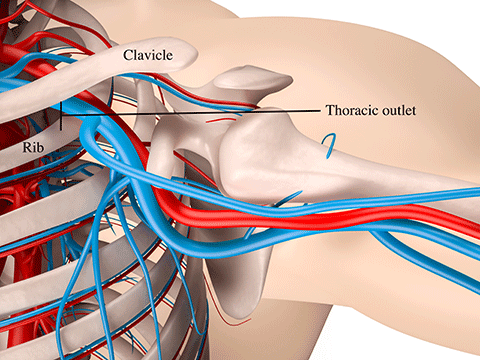About | Who Gets it | Symptoms | Treatment | Next Steps
What is Thoracic Outlet Syndrome?
Thoracic outlet syndrome is a cause of shoulder, neck, and arm discomfort that occurs when the nerves or blood vessels near the collarbone get pinched or compressed.
What is the Thoracic Outlet?

The thoracic outlet is the small area between the collarbone (clavicle) and the first rib. The nerves and blood vessels that pass through the thoracic outlet can become pinched or compressed, obstructing nerve signals and blood flow and placing chronic, repetitive strain on these structures.
There are two main types of thoracic outlet syndrome:
- Neurogenic thoracic outlet syndrome is the compression of the brachial nerves, which control muscle movement and feeling in your shoulder, arm, and hand.
- Vascular thoracic outlet syndrome is the compression of the blood vessels that pass through the thoracic outlet. There are two types of vascular thoracic outlet syndrome, based on the type of blood vessels affected:
- Venous thoracic outlet syndrome is the compression of the veins passing through the thoracic outlet. Venous thoracic outlet syndrome can result in a life-threatening condition called a pulmonary embolism, where a blood clot travels to the lungs
- Arterial thoracic outlet syndrome is the compression of the arteries passing through the thoracic outlet. This compression can cause the artery to swell and bulge, resulting in a dangerous condition called an aneurysm.
Thoracic outlet syndrome may also involve a combination of these different types.
Who Gets Thoracic Outlet Syndrome?
Thoracic outlet syndrome is often the result of physical stress to the body, which may be due to:
- Traumatic injury, like from a car accident
- Repetitive motion injuries (many cases of thoracic outlet syndrome are sports-related)
- Pregnancy
- Obesity
- Chronic poor posture
In many cases of thoracic outlet syndrome, the exact cause of the problem remains unclear.
Thoracic outlet syndrome is more commonly seen in women than men, and typically affects younger people, between the ages of 20 and 40.
What Are The Symptoms of Thoracic Outlet Syndrome?
Symptoms of vascular thoracic outlet syndrome may include:
- Neck pain
- Arm pain and swelling
- Arm weakness
- Hand discoloration (blue or pale)
- Hand numbness or tingling
- Vascular thoracic outlet syndrome may also cause dangerous blood clots in the upper body.
How Is Thoracic Outlet Syndrome Treated?
The first step in treating vascular thoracic outlet syndrome is typically avoiding repetitive stress, heavy lifting, and, if possible, correcting any underlying problems like obesity or poor posture. Physical therapy and anti-inflammatory medications may also help.
When other treatments aren’t successful, surgery may be a good option to resolve thoracic outlet syndrome. A vascular surgeon can relieve the compression on the artery or vein and treat any associated blood clots. In some cases, the vascular surgeon may need to replace a damaged portion of the blood vessel with a graft—either from elsewhere in the patient's body or an artificial graft.
Next Steps
If you think you may have vascular thoracic outlet syndrome and need to confirm the diagnosis, or if you know you have it and lifestyle changes and physical therapy haven't been effective for managing your symptoms, you can consult with a vascular surgeon to explore your options and see if surgery makes sense for you.
Our vascular surgeons are experts at diagnosing and treating thoracic outlet syndrome and are here to help you. Call us now at (646) 317-8282 or fill out our online form to get started today.
Related Topics
- Aortic Aneurysm
- Carotid Artery Disease
- Chronic Venous Insufficiency (CVI)
- Deep Vein Thrombosis (DVT)
- Minimally Invasive Vein Surgery
- Pelvic Vein Disease
- Peripheral Arterial Disease
- Renal & Mesenteric Arterial Occlusive Disease
- Sclerotherapy for Vein Disease
- Spider Veins
- Thrombophlebitis
- Varicose Veins
- Vein Disease Overview
- Venous Leg Ulcers
